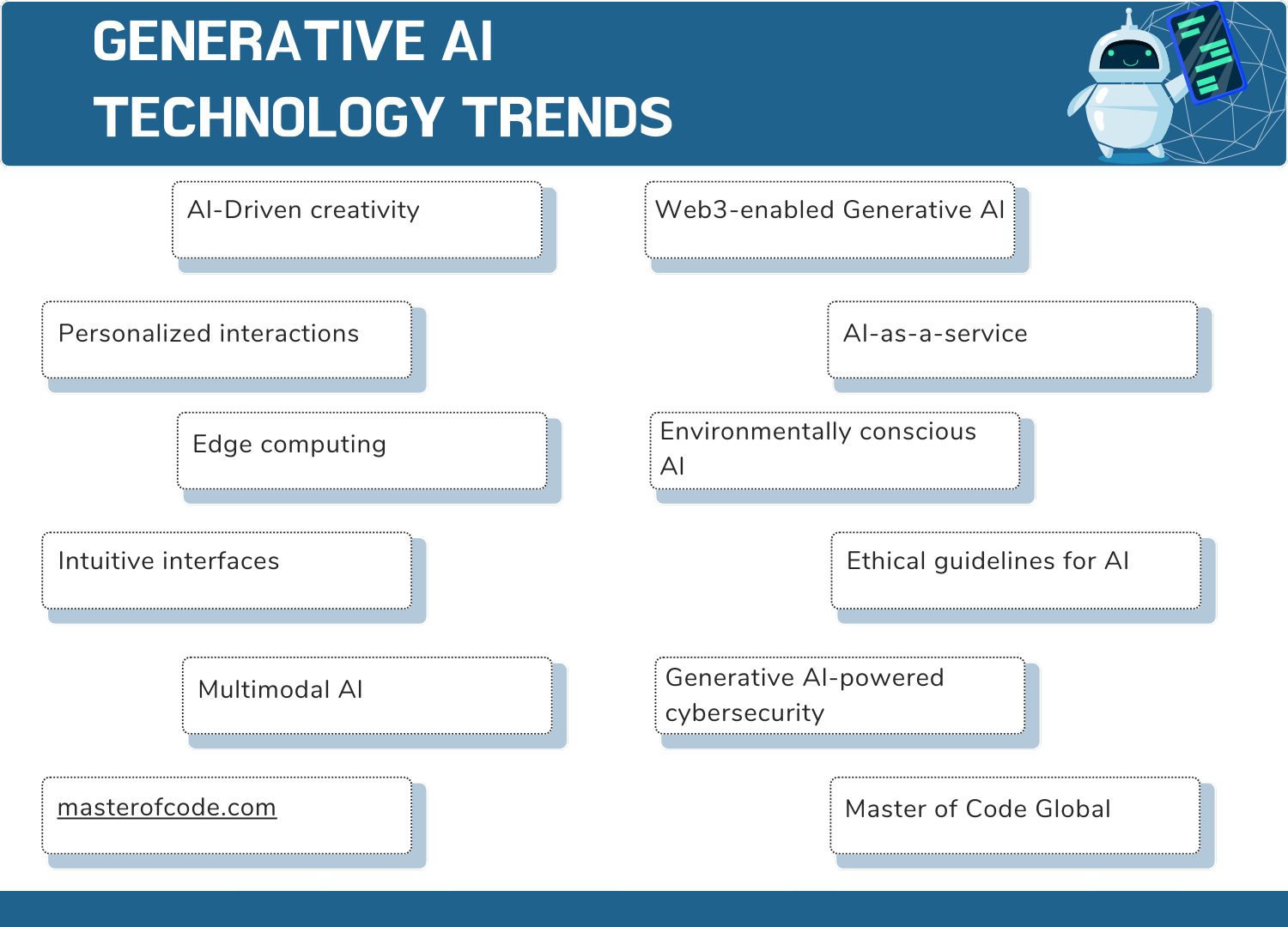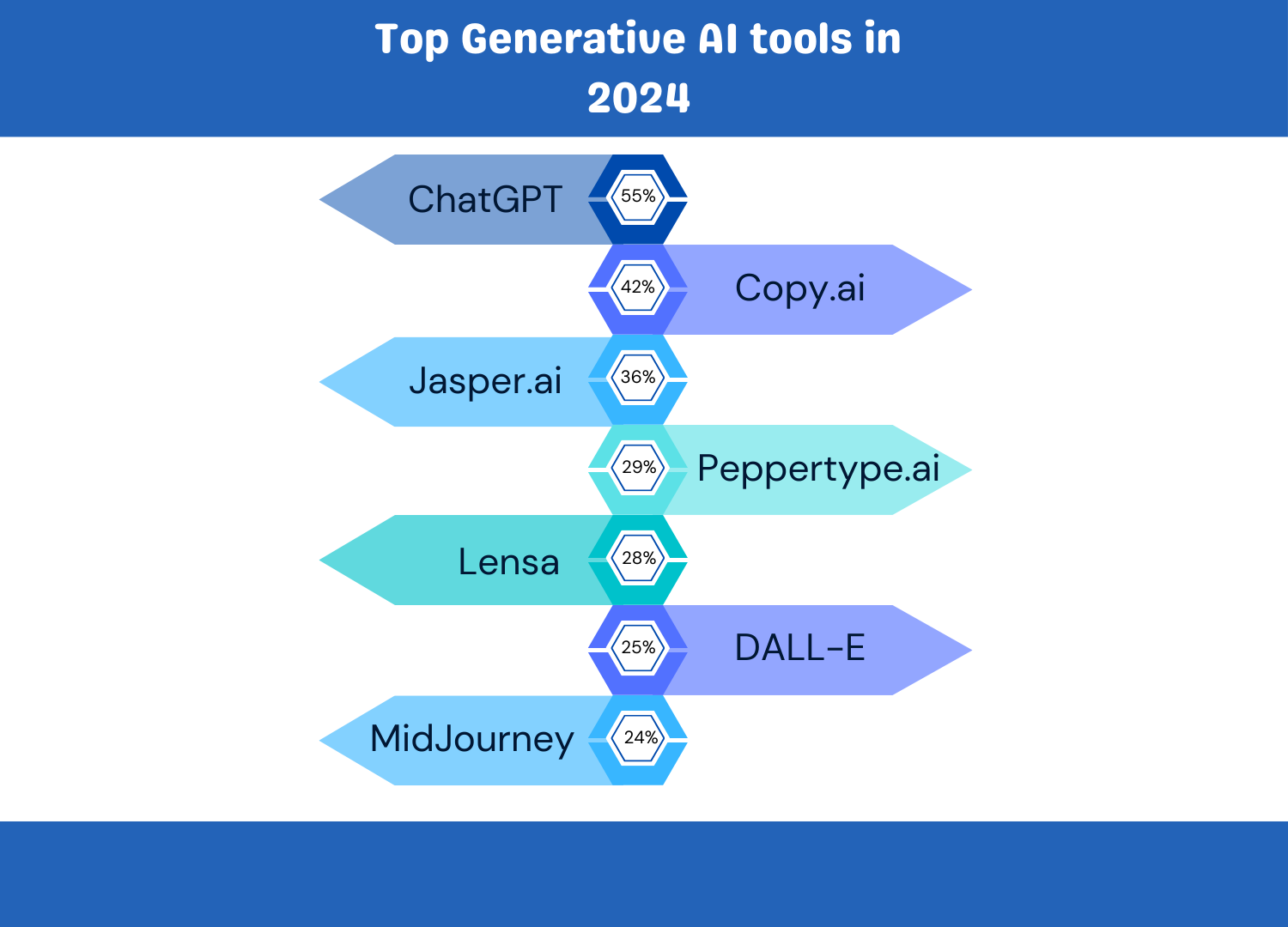Table of Contents
The use of generative artificial intelligence (GenAI) is revolutionizing both the world and how we interact with technology. Businesses rely on it as the pivot to improve, empower, and engage both customers and staff. Although Generative AI has been around for a while, the introduction of consumer-facing AI tools such as GenAI ChatGPT has propelled the innovative technology to unprecedented heights. With its revolutionary impact on workflows, streamlined operations, and redefined frontiers of organizational innovation, this evolution represents the first productivity-centric wave of Generative AI company & its impact on businesses.
“A set of technologies and techniques that leverage massive corpora of data, including large language models, to generate new content (e.g., text, video, images, audio, code),” according to Forrester, is what is meant to be understood by generative AI. The next five years should see a tenfold boost in task productivity due to generative AI trends. It is predicted to transform all knowledge-fueled tasks and roles as well as knowledge processes and resources across all industries. This isn’t just conjecture companies like KPMG, which observed a 50% increase in productivity following the implementation of Microsoft Copilot—a suite of productivity apps based on OpenAI’s large language model (LLM)—are already witnessing this.
We’ve only just begun to scratch the surface of generative AI, despite the significant improvements and the introduction of new trends. According to Forrester, the rapidly changing field of generative AI will eventually assist companies in creating new revenue streams, extensions, and avenues for significant development and self-reinvention. It will push entire sectors to realign around the value produced by machines.
Leverage AI for Strategic Advantage With Our Generative AI Expertise
The Benefits of Generative AI
In the upcoming year, 67% of AI decision-makers at Forrester anticipate seeing a rise in their organization’s investment in Generative AI development services, according to the 2025 Artificial Intelligence Pulse Survey. This emerging discipline of artificial intelligence (AI) is more than a fad. It offers a chance to spur innovation and reduce performance gaps. It offers benefits to those who use it to supplement and improve their current business processes that were not previously feasible. These include:
-
Increase the depth and breadth of human creativity for all levels of ability
Professional creators can use LLM in content creation to stretch their creative boundaries and produce fresh, original works, and even untrained individuals can produce excellent visual material with ease.
Create a lot of high-quality content. Marketers are using genAI to swiftly produce enormous amounts of varied content in dozens of languages and formats to appeal to different types of audiences.
-
Bolster app development and data science methodologies.
TuringBots, for instance, are a tool used in the early stages of the software development lifecycle, from requirements to deployment. But they are already being used to produce and improve code.
-
Add synthetic equivalents to the data
Businesses can create synthetic data with Generative AI. This enhances their data sets while maintaining privacy and confidentiality. Today, synthetic data is a part of financial services, healthcare, and other sectors. In these sectors, data privacy regulations hinder the development of AI applications. Today, synthetic data is employed in financial services, healthcare, and other sectors where data privacy regulations have impeded the development of applications of generative AI.
Generative AI companies will see enormous growth. They will surpass their rivals if they adopt generative AI technology to improve customer experiences. Generative AI helps by developing more inventive products and increasing productivity.
Current Landscape of Generative AI
The field of generative AI has seen tremendous change in the last several months. This trend seems certain to continue. Though generative artificial intelligence is just fresh, it is creating waves! Although it’s not yet widely used in companies, this innovation is becoming a hot tool for regular consumers as well as creative experts. As per McKinsey Global Survey,” 65% of respondents report that companies are regularly using Generative AI in double capacity as they were using 10 months prior“. Let’s investigate some of the incredible capabilities of generative artificial intelligence available nowadays:
- Use of large language model development for research support, conversational AI, and personal and recreational purposes, among other things.
- Coding and software development, with a focus on quality assurance reviews and code completion.
- E-commerce along with inventory control.
- Management of online and customer experiences (shopping, booking trips, research assistance, etc.).
- Text and multimedia content generation, sales, and marketing in general.
- Synthesis of voice and audio.
- Workflow automation, project management, and office support.
- creation of creative stuff, such as music, video games, and artwork.
- AI Chatbots and customer service representatives.
- Analytics driven by AI and the creation of synthetic data.
- Creation of instructional materials and virtual instruction.
- Medical diagnostics and pharmaceutical medication development.
- Supply chain management and intelligent manufacturing.
- AI risk management in finance, insurance, and related industries.
- Knowledge graphs and search.

Trends & Opportunities in Generative AI: A Closer Look at The Future
Anticipate three primary areas of focus for the future of AI: rapid and broad scientific advancements, unexpectedly rapid digital transformations, and a growing emphasis on the societal and global implications of artificial intelligence. These particular forecasts and expanding patterns are perhaps not too far off in the future:
1. Multimodality is Growing
Customers are beginning to prioritize multimodality—the notion that a generative AI tool is built to take inputs and produce outputs in several formats—and top generative AI companies are starting to take note. OpenAI was among the first to offer people access to multimodal models via GPT-4; other prominent models that have done the same include Google’s Gemini and Anthropic’s Claude 3. However, the majority of Generative AI companies have not yet made multimodal models publicly available, and even those that do have considerable restrictions on the inputs and outputs they can use.
Multimodal generative AI is expected to become the standard for all paid LLM memberships soon, less of a differentiator and more of a consumer expectation.
To satisfy consumer demands for an all-in-one solution, multimodal modeling itself should also continue to advance in accuracy and complexity. This could mean introducing more features and capabilities for things like movies, file attachments (as Claude has already done), and internet search widgets (like Gemini has previously done), or it could mean boosting the quality of image and non-text outputs.
Currently, users can work with text (including code), speech, and image inputs and outputs using ChatGPT. However, GenAI ChatGPT does not support video input or output. This could soon change, as OpenAI is testing out a new text-to-video tool called Sora. Like DALL-E, ChatGPT will probably integrate some of Sora’s features.
Similar to this, Google’s Gemini can currently generate photos with people, but there are significant restrictions on the image possibilities. It can currently only generate text, code, image, and voice inputs and outputs. It appears that Google is actively addressing this constraint in the background, which gives me hope that it will soon be lifted.
2. More People Using AI as a Service
While AI as a service is starting to gain traction in corporate use cases related to machine learning and artificial intelligence, generative AI development is still in its infancy. But as generative AI technology becomes more widely used, a lot more companies will begin to experience the pain of being behind their rivals. When this occurs, businesses that lack the resources to create internal AI teams and generative AI models will probably turn to managed services providers and AI consultants who have experience with similar projects or industries and who specialize in generative AI.
Pay particular attention to the rise in market share of AI modeling as a service, or AIMaaS. To access new markets, more AI firms will want to make their lightweight, adaptable, and/or open-source models available to the general public. Initiatives that offer generative AI tools as a service can also place a strong emphasis on the infrastructure that companies require to use generative AI effectively. As a result, more businesses will inevitably specialize, while other businesses will invest in services like AI security , management and governance.
3. Advancement of AGI and Related Research
Artificial general intelligence (AGI) is a popular term among Generative AI companies today, although it doesn’t mean much more than the idea that AI would eventually surpass humans in most taskwork and critical thinking assignments.
Among the pioneers in defining and innovating in this field are Google’s DeepMind, OpenAI, Meta, Adept AI, and others. There isn’t much consensus yet on what artificial general intelligence (AGI) is, how it will manifest, and how AI leaders will determine when they have achieved AGI.
Up until now, most AGI research and development has taken place in isolated areas. AI will remain a top priority for research and development in the future. But, like other significant tech and AI projects in the past, it probably will become more collaborative, if only to create a unified definition and framework for the idea. While Artificial intelligence companies strive to more precisely define artificial general intelligence (AGI), generative AI will continue to move closer to this objective even though Generative AI development services may not achieve actual AGI or anything close to it in the upcoming years.
4. Considerable Disruption and Reformation of the Workforce
The majority of experts and industry leaders concur that generative AI tools will drastically alter the nature of the job and workplace, but they disagree as to whether this will benefit or hurt workers in the long run. Generative AI tools are mainly helping office workers with automation, AI-powered content and recommendations, analytics, and other tools to assist them get through their more routine and mundane jobs at this early stage of workforce impact. Even though there is some mistrust among employees and organizations alike, new users are still finding that generative AI can assist them with tasks like email drafting and dispatch, report preparation, and social media content creation, freeing up time for more strategic work.
Generative AI models have already demonstrated its early ability to fundamentally alter the way we operate across departments, roles, industries, and sectors, even with these more basic use cases. Despite early expectations that it would primarily handle assembly line, manufacturing, and other physical labor activities, generative AI has had the most immediate and significant effects on jobs and tasks related to creativity, clerical work, and customer service.
Employees in industries including marketing, sales, design, development, customer service, office management, and assistantship are already experiencing the effects of this technological advancement. They fear that the generative AI services may eventually cause them to lose their employment. In fact, the majority of experts concur that in a few years, these and other vocations won’t look the same as they do now. Regarding what the “refactored” workforce for these individuals would look like—will their jobs just change or be completely eliminated—different people have different ideas.
Workplaces and academic institutions are now developing courses, generative AI certifications, and training programs for professional usage of AI models and generative AI in light of all of these uncertainties and anxieties. AI study programs at the undergraduate and graduate levels are starting to appear, and in the upcoming months and years, this degree path might become as popular as computer science or data science programs.
5. Growing Pressure from Society, Ethics, and Regulation
After several years of discussion and assessment, the EU Parliament officially enacted the EU AI Act in March 2025. Organizations using AI within the EU or about data belonging to EU citizens will be subject to this new rule and its requirements in the upcoming months and years.
Although this is the first significant rule addressing applications of generative AI and its implications for data privacy, don’t expect it to be the last as concerns from consumers and society as a whole rise. In addition to various businesses having their frameworks and laws for the use of generative AI, there are already state restrictions in place in California, Virginia, and Colorado.
Globally, the UN has started to talk about the significance of responsible AI development and use through established global frameworks, international engagement and cooperation, and AI governance. This is a crucial discussion that will probably shape how many nations and areas approach ethical AI and regulation, even though it is unlikely that it will become an enforceable global policy.
Advanced AI Solution Awaits! Discover Our AI Services
Challenges in Adoption of Generative AI
Be mindful of these possible problems before committing fully to generative AI.
Consequences for Society and Ethics
Fairness and Bias: Generative AI systems have the potential to reinforce or even magnify biases in the training data. This may result in biased behaviors or unfair results, particularly in delicate areas like recruiting, lending, and law enforcement. To reduce these risks, technology companies need to make investments in de-biasing methods and guarantee diversified datasets.
Privacy Issues: Deepfakes and other realistic synthetic data can be produced by generative AI, which presents serious privacy issues. Companies need to tread carefully when using generative AI tools to innovate while also protecting people’s right to privacy. This calls for strong privacy safeguards and moral standards.
Misinformation: Generative AI can easily produce realistic text, photos, and videos. These can be used to create convincing fake news and misinformation. Developing efficient identification and moderation technologies is especially difficult for businesses that produce material for social media sites.
Operational and Technical Difficulties
Information Needs:
Generative AI models need enormous amounts of data to train. The quality of the model depends on the data it gets training on. To generate meaningful information, you must ensure that the data is relevant and of high quality. Furthermore, organized data is typically necessary for AI models to function at their best. You will need to invest a lot of time and considerable resources in reworking unstructured data if your company handles a large amount of it.
Computational Costs:
For small and medium-sized businesses (SMEs), in particular, the computational resources required to train and operate complex generative AI models may be expensive. Potential solutions include more cost-effective model architectures and cloud-based AI services, although costs are still an issue.
Integration and Scalability:
It might be difficult to incorporate generative AI into current workflows and systems without making significant changes. Furthermore, it gets harder to maintain the effectiveness and dependability of AI systems as firms grow.
Security needs:
Generative AI models need to be shielded from overexposure, theft, and corruption. If not, models run the risk of being compromised, disclosing private information, or giving clients and businesses incorrect advice.
Skill Gap:
Professionals with the ability to create, implement, and oversee generative AI systems are in limited supply in the field of artificial intelligence. Businesses must make investments in education and training if they are to meet this challenge.
Legal and Regulatory Concerns
Concerns about intellectual property (IP): Content creation by generative AI presents complicated intellectual property (IP) challenges, especially those involving ownership and copyright violation. Companies must carefully handle these legal nuances to steer clear of lawsuits and guarantee creators receive just pay.
Liability and Compliance: As governments throughout the world start to enact laws controlling AI, technology companies may find it increasingly difficult to comply. Determining culpability in situations when AI systems hurt people or make bad decisions is also a persistent legal problem.
How to Take Advantage of The Promising Opportunities of GenAI
Whether or not your company decides to use generative AI, it is obvious that this technology is here to stay. Setting clear goals for the beneficial use of AI tools and approaching the task with well-defined, successful AI tactics are essential to working with generative AI without allowing it to take over your company’s priorities. A few of these tactics could be useful:
Develop an AI Plan That Is Particular to Your Company
What technologies can be employed, who can use them, how to use them, and other details should all be included in this approach. As goals, rules, and technologies change, it is important to maintain flexibility and iteration in plans and policies. A generative AI company can assist in developing a framework for your company.
Assist Workers in Changing Roles and Work Environments
With the speed at which generative AI innovation is developing, it seems unlikely that current employment will survive or even thrive. Be the kind of employer who provides resources for upskilling and training that will benefit employees and your business in the long run. Ultimately, it would also help in relieving the employee from the risks of layoffs.
Think Collectively and Globally
If you have the means or the influence to do so, think about working to lessen the growing disparities in the world that will probably result from the widespread use of generative AI.
Join together with businesses in underdeveloped nations, strive toward advancements in generative AI development that benefit people and the environment, and support globally impartial data training and multilingual solutions. Better technologies and results will generally result from collaborating with leaders in other nations and organizations.
Take Care When Embracing AI Innovations
Use caution while utilizing generative AI tools and the way these tools interact with your data and intellectual property, especially when pursuing AGI. Although generative AI offers a lot of promising applications, there is also a chance that it could be harmful. Observe the developments in generative AI and don’t hesitate to hold AI businesses responsible for adopting a more conscientious AI strategy.

Eight Use Cases for Generative AI
Nowadays, generative artificial intelligence is a strategic priority rather than a nice-to-have. However, integrating it into business operations could appear overwhelming given its complexity and wide range of possible uses. Businesses should first identify areas in their current operations where generative AI might make improvements and investigate realistic, quantifiable use cases to fully realize the promise of this technology.
-
Improved CX Accessibility and Interaction
Customers in today’s market demand more individualized care and services that cater to their particular likes and habits. Client service representatives can create more meaningful interactions that profoundly resonate with customers’ needs by using an AI development company, which provides them with advanced capabilities to evaluate and distill large amounts of client data without having to repeatedly request information. Additionally, an artificial intelligence solutions company gives service teams the capacity to swiftly assess and synthesize massive amounts of feedback, maintaining customer privacy and data integrity while improving accuracy in responding to issues. This proactive strategy promotes a more responsive and intuitive customer experience (CX) that increases happiness and loyalty.
-
Customer Support
It is a common practice to deploy AI in customer service environments like call centers and automated self-service systems (like chatbots). These classic AI systems adhere to rigid, predefined rules or scripts, which can make user interactions rigid and occasionally annoying. The client experience greatly improves with GenAI. This is due to its dynamic, contextual and ability to provide intelligent and well-spoken responses. Generative AI development company enhances the capabilities of customer service team members in a background, enabling agents to provide superior customer support by addressing the primary drivers of customer experience (CX): responding to inquiries more quickly and efficiently, addressing issues promptly, understandably conveying information, and leaving the customer feeling valued.
A Generative AI company should carefully develop, deploy, and evaluate the impact of these creative solutions inside their customer service operations to make sure that new generative AI-powered customer service tools complement and fit with overall customer experience goals.
-
Generative AI for Knowledge Sharing and Next-Generation Search
A workforce that is better informed and connected thanks to dynamic information sharing and updating is made possible by a Generative AI company. To increase efficiency and streamline processes, businesses can just as simply ask GenAI ChatGPT for information as they can by using their abundance of private data. Employees may make decisions more quickly and focus on more strategic tasks that benefit the company by reducing the amount of time they spend looking for data. In addition to summarizing meetings and identifying action items, GenAI may also suggest resources related to conversation topics, draw lessons from previous projects to guide current work, and even automatically create knowledge articles based on interactions with clients or staff. Businesses that integrate genAI create an environment where knowledge is always being learned and updated, making it available to all.
-
Productivity of Developers
TuringBots are improving multiple stages of the development process, which is revolutionizing the way enterprise software is developed. Encoding TuringBots, like GitHub Copilot, employ simple prompts to generate code that is ready for testing. They can also find and fix bugs in the code, which makes the unit testing stage more efficient. Furthermore, a lot of Generative AI companies are currently automating visual testing of hundreds of GUIs across browsers, mobile devices, and other platforms utilizing sophisticated tester TuringBots.
-
Innovation in Data
Along with a variety of specialized benefits, data scientists are finding the same advantages to hire AI developers (especially when it comes to leveraging TuringBots to assist ModelOps and DataOps). It provides methods and AI tools for creating large data sets for analysis or training machine learning models and is already a major player in the synthetic data space. These days, data scientists may produce synthetic data sets of text, photos, structured data, and even whole 3D worlds using vendor tools and top large language models. They will leverage these developments tomorrow to improve narrative and data visualization tools, providing more practical and accessible insights through intricate, artificial intelligence (AI)-)-generated infographics and interactive data representations.
-
Intelligence on Threats
Generative AI is being used by security experts to bolster their defenses. Generative AI models, for instance, can be used to self-document system behaviors and functionality, generate biometric data for penetration testing, and sort through emails to look for indications of phishing or other social engineering assaults. We anticipate that generative AI in security will be utilized in the future to identify and record IT system flaws and proactively provide fix options to security experts.
-
Sales Optimization
Sales teams may create personalized sales scripts to facilitate more meaningful discussions, quickly create pitch decks to concisely communicate value to their audience, and enhance response rates by using generative AI. In addition, Generative AI services in sales are being used to draft article summaries, generate contact email ideas, and even make sure that language is inclusive.
-
Content Creation
By optimizing the processes involved in content development and design, generative AI tools are completely changing the marketing role. AI can be a game changer for professionals:
For marketers, artificial intelligence can be a content powerhouse. Imagine producing hundreds of blog entries, email newsletters, and social media material that exactly embodies the voice of your company and hooks your readers. That’s artificial intelligence working magic.
Generative AI in graphic design works on resizing photographs or removing backgrounds—regular chores like these. Still, it improves even more. AI may also inspire fresh creative ideas and enable designers to iterate on ideas far faster. It therefore streamlines and improves the design process. Therefore, marketing teams can complete more tasks in less time and redirect resources to other goals that generate money. In the future, marketers will be able to develop and carry out more precisely targeted campaigns and communications by hiring a generative AI company to quickly generate several content pieces from a single source.
Improve Operational Efficiency of Business With Generative AI
Conclusion
The amazing potential of generative AI to drastically alter economies, communities, and industries has already been demonstrated. Research organizations and top AI solution providers are constantly revising their projections regarding the development of generative AI as they become aware that the technology might be able to perform more of the cognitive and physical labor performed by human workers — and much sooner than previously thought — than previously believed.
But extreme prudence and meticulous forethought should accompany this amazing technological advancement. The ethical implications of generative AI must be taken into account by both AI consulting companies and users. Efforts must be made to maintain transparency, explainability, and alignment. Keep in mind the public views on appropriate applications of this technology. They also need to think about some of the more far-reaching effects, like widening wealth gaps and environmental degradation. They must come up with innovative ways to develop generative AI that benefits society more than it harms.
What therefore is the best course of action for generative AI’s bright future? Cooperation. To secure a future that benefits everyone, the users, and skeptics of a generative AI company from all over the world must work together. They must jointly handle the opportunities and difficulties posed by generative AI.
FAQs
What is the landscape of generative AI?
Within machine learning, generative artificial intelligence (AI) is a rapidly developing discipline that centers on creating original, never-before-seen information. This information could take many different forms, such as writings, audio, photos, or even intricate data sets.
Which are some of the generative AI’s challenges?
Data security and privacy are two major issues that businesses may run into while deploying generative AI. Large data sets are essential for generative AI models to produce results that are precise and significant. But managing that much sensitive data might raise issues with security and privacy.
Which popular uses of generative AI are there?
Generative AI has applications in various fields. A few of the most well-liked uses are text and picture generating, medication discovery, virtual avatars in virtual reality and games, content creation, medical image synthesis, and fashion design. Furthermore, generative AI is improving marketing strategies through automated content production and revolutionizing customer care with intelligent chatbots.
How is the competitive environment for generative AI changing?
There is fierce competition in the generative AI space. Especially between academic institutes, startups, and tech giants. To enhance generative AI capabilities, major corporations like Google, Facebook, and OpenAI heavily spend on research and development. Additionally, startups are sprouting up, offering specialized AI solutions to a range of industries. Using published papers and open-source projects, academic institutions and research labs make a substantial contribution towards promoting further innovation.






